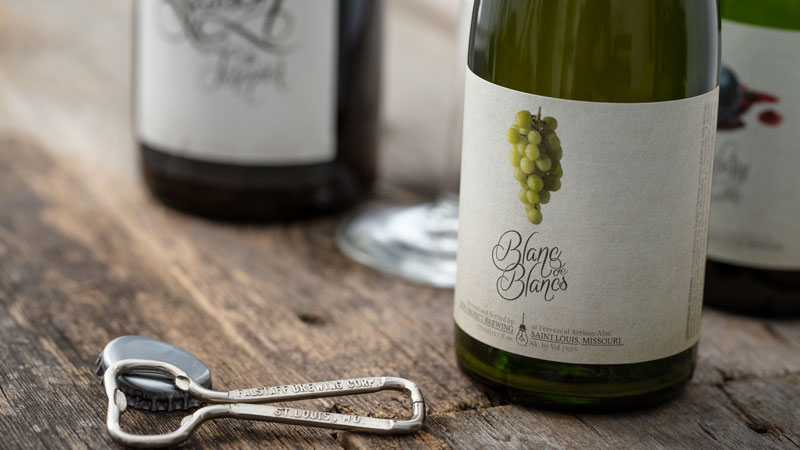Unless you’ve been living under a beer-repellant rock, you’ve likely heard the word “brut” thrown around the beer world lately. This is mostly due to the recently emerged, rapidly spreading brut IPA category.
But “brut” is not new to brews. Brewers have been experimenting with the sparkling-wine-inspired method for at least a decade. Called bière brut, or bière de Champagne, bottle-conditioned, effervescent beers are are produced in, or inspired by, the méthode Champenoise (Champagne method). The ancient technique is also known as the méthode traditionelle or méthode originale.
Its adaptation to beer yields bubbly, fruity, bone-dry brews worthy of any celebration. Bière brut is currently making a splash around the world yet again, as trendy brewers like Cloudwater, Side Project Brewing, and Mikkeller release iterations of the Champagne-inspired style.
Scientific Method
Bière brut is defined more by its production method than by style. Typically, it is very effervescent, high-gravity (8 percent ABV or more) and light-bodied, like sparkling wine. But what truly puts the “brut” in brut beer is what happens after it’s bottled, not its ingredients.
All brut beers are bottle-conditioned, but not all bottle-conditioned beers are brut. For a bottle-conditioned beer to become a bière brut, it must undergo secondary fermentation using Champagne yeast (as opposed to ale yeast), and then be riddled and disgorged (remuage and dégorgement).
“Riddling” means bottles are aged on their sides, positioned so the bases of the bottles sit slightly higher than the tops, so sediment can settle in the neck. As the liquid ages over the course of several months, bottles are routinely twisted so sediment on the sides of the bottle can loosen. “Disgorging” refers to the next step, when the bottle necks are placed in a cold bath that flash-freezes the liquid inside, and the bottles are carefully opened so the frozen block of solid sediment pops out, while the beer remains intact.
Voila! What’s left is a clear, sparkling brew akin to a sparkling wine.
L’Histoire de Bière Brut
Bière brut’s story begins in the early 2000s. As such it is not to be confused with the American-made Champagne of beers (we all know that one) or Berliner weisse, Germany’s Champagne of the North. Last but not least, it doesn’t even share that much in common with brut IPA, which is generally not produced using the méthode Champenoise.
As legend has it, beer writer Michael Jackson visited Malheur brewery in Belgium and asked its owner, Manu De Landtsheer, what his dream was. “Manu replied that he wanted to make a beer like they make Champagne in France,” Thomas De Moor, Malheur’s head brewer, once told Belgian Smaak.
That dream was realized in Malheur Bière Brut, a Belgian strong ale re-fermented up to three times in the bottle with Champagne yeast, then riddled and disgorged. The beer, released in 2002, is widely considered to be the first beer made with the méthode Champenoise. Wine Enthusiast called it “first and foremost a beer, albeit an extraordinary and most unusual one.”
Also in 2002, Brouwerij Bosteels introduced DeuS (Brut Des Flanders). This bière brut took the Champagne influence even further, shipping its bottles to a Champagne house to be truly treated in the méthode traditionelle.
Imitation may be the sincerest form of flattery but, in Bosteels’ case, it proved to be problematic. Its corked-and-caged, Champagne-like bottle was reportedly so similar to that of Dom Perignon that the famous Champagne house threatened to sue Bosteels for trademark infringement.
(Malheur also got a slap on the wrist when it advertised its bière brut as the “Veuve Clicquot of the beer world,” BeerAdvocate reports. Clearly, these Champagne producers were not happy about brewers stepping on their protected turf.)
Nevertheless, both breweries continued producing Champagne-style labels. Bosteels added Dominus Vobiscum Brut, a bière brut produced in-house, to its lineup; and Malheur added Malheur Dark Brut.
By the 2010s, bière bruts were popping up around the world. MicroBrasserie Charlevoix in Québec, Canada, debuted its version, called Dominus Vobiscum Brut, in 2010. Mikkeller released its Nelson Sauvignon Bière Brut in 2011, and was soon followed by several others.
In 2014, Morada Cia Etílica, a brewery in Curitiba, Brazil, introduced its Double Vienna Brut, an 11.5 percent-ABV double Vienna lager. It is re-fermented with Champagne yeast, cellared for 18 months, and riddled and disgorged.
In the U.S., the bière brut methodology is a bit more fluid. Golden Valley Brewery in Portland, Ore., is generally regarded as the first American brewery to try the style with its IPA VS Brut, released in 2006. A double IPA aged in used Chardonnay barrels from the Argyle Winery in nearby Dundee, Ore., IPA VS Brut was bottled via méthode Champenoise.
Craft brewers, ever the innovators, have continued to expand the bière brut trend. Geeky new labels and industry veterans alike are launching iterations of the “style.” Side Project Brewing, in St. Louis, Mo., is a small brewery started by Perennial Artisan Ales’ former head brewer Cory King. It debuted its Blanc de Blancs bière brut, fermented in Chardonnay barrels with Missouri-grown Chardonnel grapes, in 2014. Meanwhile, longstanding craft beer label Victory Brewing of Downington, Pa., introduced Jubilee, a Belgian-style ale fermented with sparkling wine yeast and German blanc hops, in 2016.
Fashion changes quickly in craft beer, as our attentions shift from juice bombs to milkshakes at a moment’s notice. Bière brut is the rare trend that is both centuries-old and cutting-edge.

Five Modern, Champagne-Style Beers to Try
Side Project Brewing Blanc de Blancs (Blend #2)
